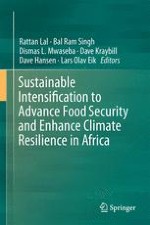Abstract
Aridity is becoming a key threat to more than 500 million people who depend on agriculture for their livelihood in semi-arid areas worldwide. Climate change represents a significant threat to current agricultural production, and consequently to farmers’ livelihoods in sub-Saharan Africa. The compounded effects of climate change, population pressure and change in dietary demands will further threaten fragile natural resources and accelerate land degradation processes. Poverty and hunger are still characteristics of sub-Saharan African countries in specific areas frequently hit by drought including the central zone of Tanzania. Typical characteristics of these areas are periodic to frequent dry spells that lead to crop failure, food shortage and lasting poverty. In Tanzania, the central regions of Dodoma and Singida are frequently threatened by drought that causes crop failure. In Dodoma, Singida and Tabora, 45–55 % of the households are food insecure. The purpose of this work was to investigate the effect of combining selected soil water harvesting techniques and locally available plant nutrient sources (FYM and urea-treated local phosphate rock, Minjingu Mazao) on the grain yield of early maturing and drought-resistant sorghum varieties (Wahi and Hakika). The trials were conducted at Mbande village, Kongwa District and Ikhanoda village, Singida Rural District in Tanzania. A split-split plot design setup was used in this study. The main plots were tillage methods, which were infiltration pit (PI), tied-ridging (TR) and flat cultivation (FC). The sub-plots were the fertilizers, which were farmyard manure and Minjingu Mazao, and the sub-sub plots were the two sorghum (Sorghum bicolor L. Moench) varieties: Wahi and Hakika. Data were subjected to one-way analysis of variance. Treatment differences were separated using least significant differences (LSD) at p < 0.05, p < 0.01 and p < 0.001. At the Ikhanoda study site, when Minjingu Mazao was applied, the Wahi grain yield was significantly (p < 0.05) higher in PI (2,414 kg ha−1) and FC (1,126 kg ha−1) than in TR treatment (648 kg ha−1). In contrast, with Hakika, TR significantly (p < 0.05) outperformed other water harvesting methods with the highest grain yield (3,199 kg ha−1). The PI treatment recorded the highest grain yield (2,789 kg ha−1 under Wahi and 3,223 kg ha−1 under Hakika) when FYM was applied at 5 t ha−1. The grain yield of both varieties under FYM and all water harvesting techniques, including FC, did not differ significantly (p > 0.05). However, Hakika under PI had the best yield (3,223 kg ha−1) while Wahi under FC registered the lowest yield (2,573 kg ha−1). In the absence of FYM or Minjingu Mazao, the grain yield showed the following trend: FC (1,660 kg ha−1, 1,863 kg ha−1) > PI (1,234 kg ha−1, 1,387 kg ha−1) > TR (875 kg ha−1, 930 kg ha−1) for Wahi and Hakika, respectively. At the Mbande site, the Wahi variety had a significantly higher grain yield (p < 0.05) in the FC treatment (1058.6 kg ha−1) than TR (543 kg ha−1) and PI (320.3 kg ha−1) when FYM was applied. With the application of 5 tons ha−1 FYM, the Wahi variety gave a significantly (p < 0.05) higher grain yield (1320.2 kg ha−1) in the TR treatment but the lowest in the FC treatment (476.6 kg ha−1). With the Hakika variety, the grain yield was higher (1773.4 kg ha−1) in TR and FC than in PI (890.6 kg ha−1). The superiority of the FC treatment in the absence of external nutrient input is attributed to topsoil that is slightly richer in nutrients compared to the rest of the treatments in which the poorer subsoil is part of the root zone. External nutrient input might have compensated for nutrient deficiencies and thus attenuated the treatment differences. This study demonstrated that in the absence of external sources of plant nutrients such as FYM and Minjingu Mazao, FC performed better than PI and TR. With external nutrient input, the grain yield varied due to water harvesting practice and site. At Ikhanoda, PI was superior to the other treatments while at Mbande, TR outperformed the other treatments. The outcome of the use of rainwater harvesting technologies ought to be applied in well-characterized fields in terms of physical and bio-chemical soil characteristics for better results.
